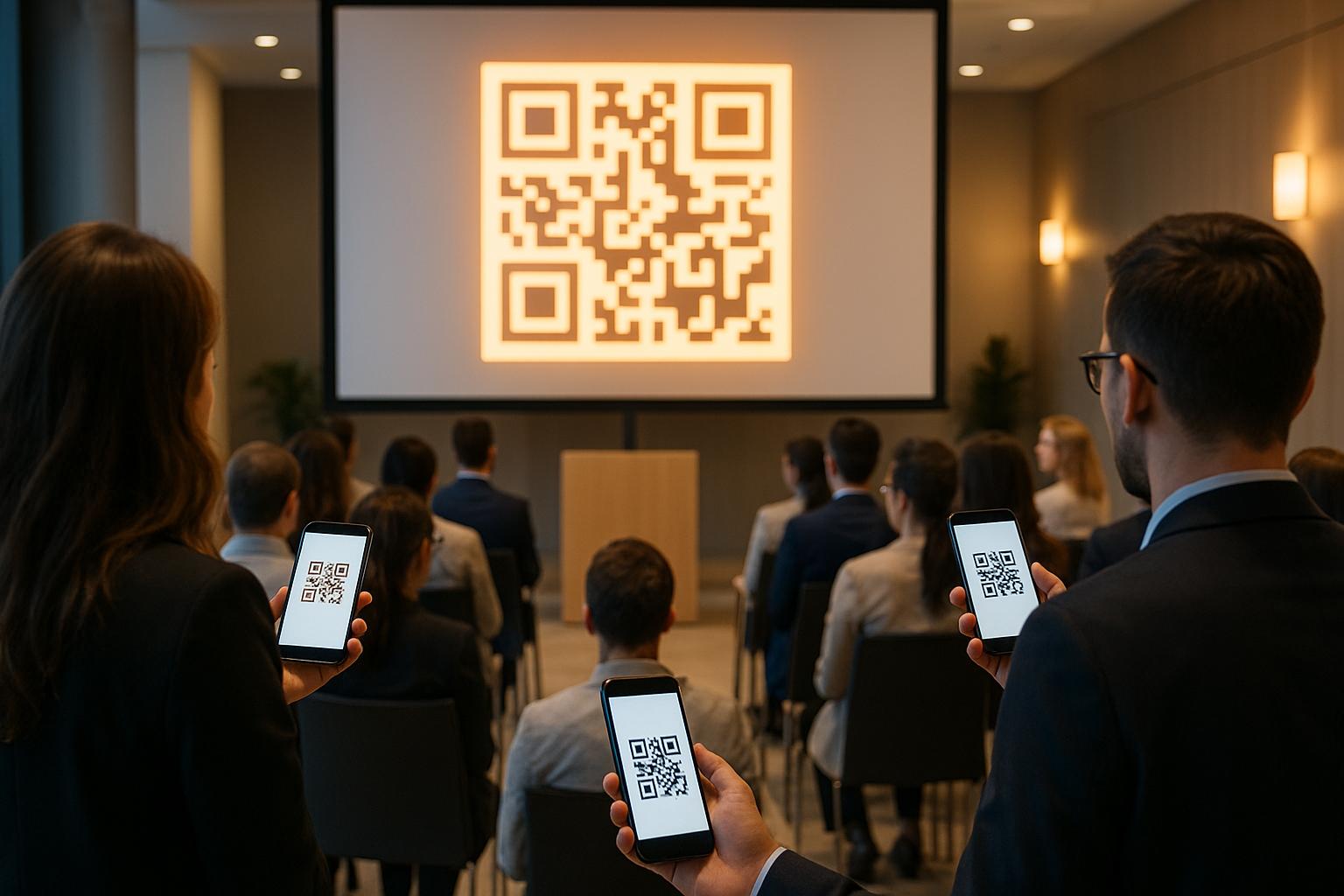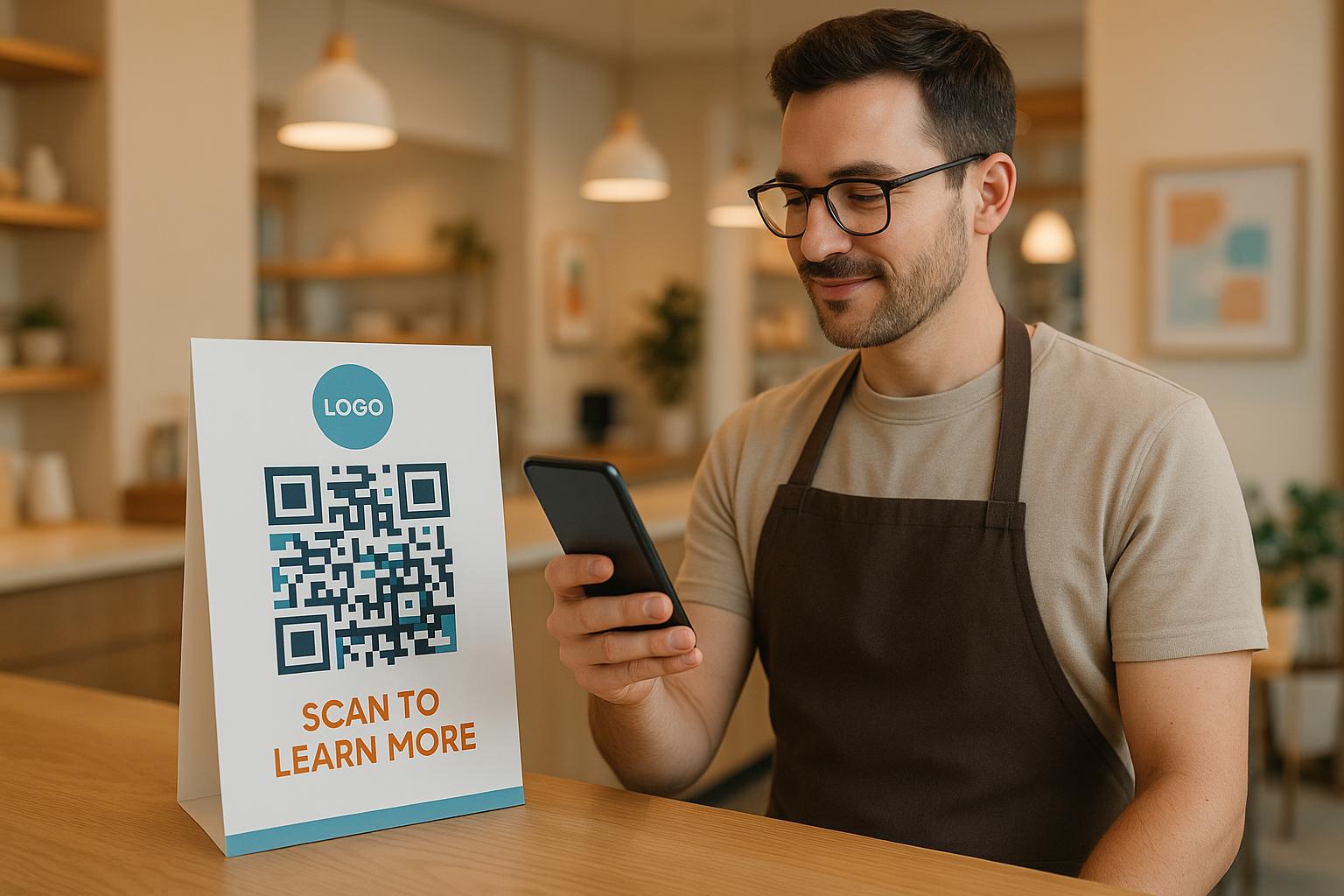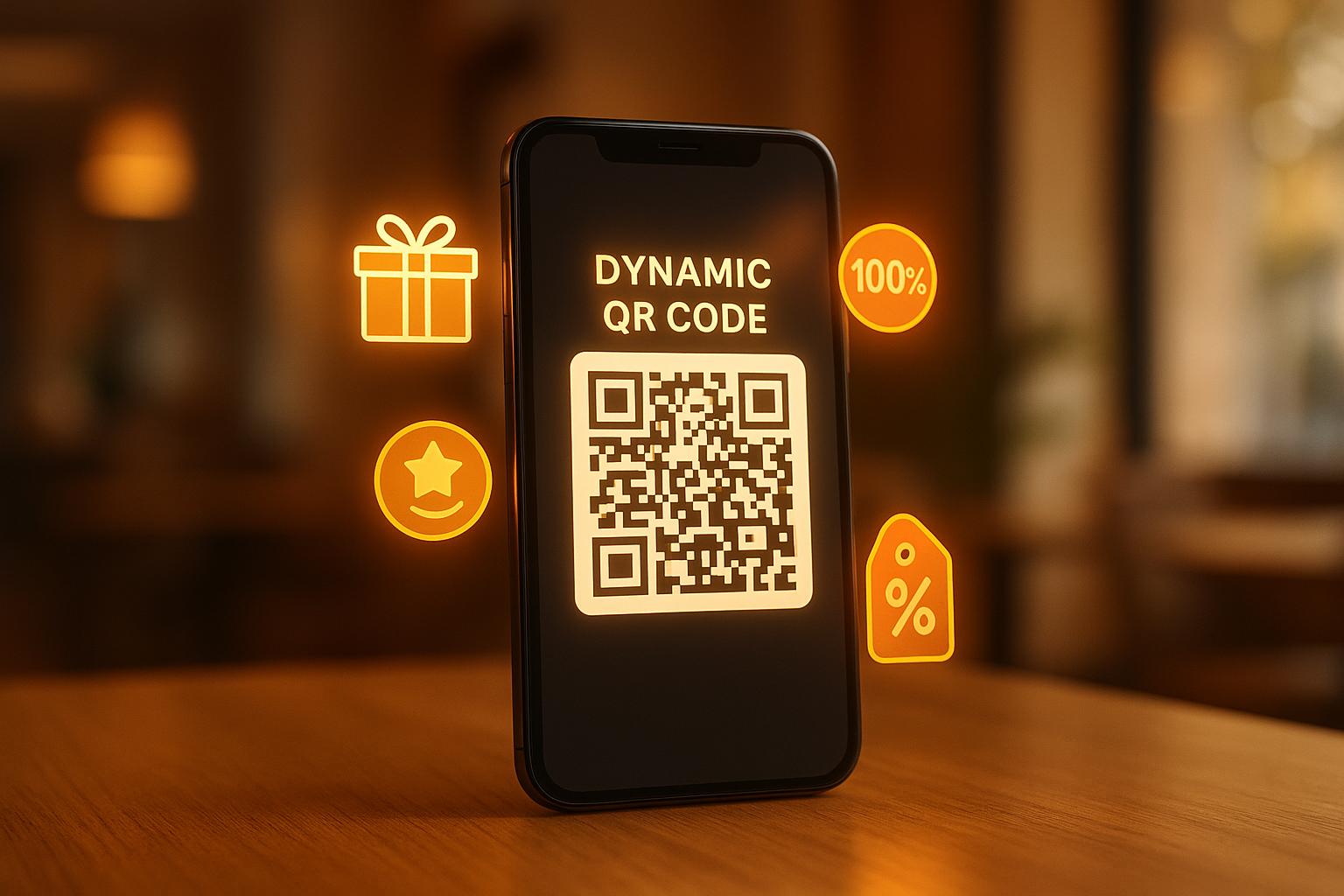Cloud-based QR code sharing simplifies event management by enabling real-time updates, centralized control, and detailed analytics. Unlike static QR codes, these dynamic codes let you update event details like schedules or venues without reprinting materials. They also improve attendee engagement by offering personalized content, multimedia access, and seamless networking options. Platforms like Pageloot make it easy to create, customize, and manage QR codes for various event needs, from ticketing to feedback collection.
Key Benefits:
- Real-Time Updates: Modify linked content instantly without reprinting.
- Centralized Management: Oversee all event QR codes from one platform.
- Enhanced Engagement: Provide personalized schedules, videos, or digital business cards.
- Analytics: Track scan data, engagement patterns, and device usage.
- Cost-Effective: Save on printing by using dynamic codes.
How It Works:
- Use a platform like Pageloot to create event-specific QR codes.
- Customize codes with logos, colors, and call-to-action text.
- Choose QR code types based on event goals (e.g., link, PDF, vCard).
- Update content dynamically as needed.
- Monitor attendee interactions using analytics.
Security Features:
- Password-protected codes
- Expiration times and scan limits
- Data encryption and privacy compliance
Cloud-based QR codes are transforming event planning by streamlining processes, reducing costs, and improving attendee experiences. Start by creating dynamic QR codes tailored to your event’s needs to ensure a smooth and interactive experience for all.
5 ways to use a QR code for events planning and management
How to Set Up QR Codes for Events Using Cloud Platforms
Cloud platforms make setting up QR codes for events straightforward while giving you control over your event materials. They also allow for real-time updates, which can be a game-changer for event management.
Creating Event-Specific QR Codes
To get started, choose a reliable cloud platform that meets your event’s needs. Platforms like Pageloot simplify this process with tools like their free QR generator, which doesn’t require immediate signup for basic codes.
Decide what the QR code will link to – registration pages, schedules, or ticketing systems. For registration, link directly to your event’s signup page or ticketing platform. If you’re sharing schedules, a PDF QR code is ideal for distributing detailed programs that attendees can download and access offline.
Once you’ve logged into your chosen platform, select the type of QR code that aligns with your goals. For general event websites or registration links, a standard link QR code works perfectly. For networking events, vCard QR codes allow attendees and speakers to exchange contact information instantly.
Next, input your event details – name, date, location, and the URL or content the QR code will direct users to. Dynamic QR codes are especially useful because they let you update the linked content without reprinting the code. This feature is invaluable if schedules change or new venue details need to be shared.
After entering the necessary details, the platform generates your QR code instantly. You can download it in formats like PNG or vector files, making it easy to use on tickets and posters.
Customizing QR Codes for Branding
Once your QR code is set up, take it a step further by customizing it to match your event’s branding. Cohesive branding not only looks professional but also builds trust with attendees.
Start by adding your event logo. Most platforms allow you to upload a logo directly into the QR code design. Typically, the logo is placed in the center, and the system adjusts error correction to ensure the code remains scannable. Just make sure your logo doesn’t overpower the design – keep it appropriately sized to maintain functionality.
Color customization is another way to align the QR code with your event’s theme. Use your brand’s primary colors for the code and complementary tones for the background. However, ensure there’s enough contrast for the code to scan reliably under various lighting conditions.
Platforms like Pageloot offer templates tailored for different event types. These templates include features like frames, call-to-action text, and design elements that encourage scanning. For instance, adding text such as "Scan for Event Schedule" or "Get Your Digital Ticket" makes it clear what attendees will access when they scan the code.
Custom frames can also enhance the QR code’s appearance, incorporating event branding elements while providing clear scanning instructions. These frames add a polished look to printed materials and digital displays without affecting the code’s functionality.
Choosing the Right QR Code Type
After customizing your QR code, it’s time to select the type that best serves your event’s objectives.
- Link QR Codes: Perfect for directing attendees to event websites, registration pages, or live streaming links. These are especially effective for marketing agency events where driving traffic to specific landing pages is crucial.
- PDF QR Codes: Ideal for sharing static materials like event programs, speaker bios, venue maps, or guides. Attendees can download these materials for offline use, making them great for education events or conferences requiring detailed handouts.
- Video QR Codes: Enhance engagement by linking to welcome messages, event highlights, or instructional videos. These work well for product launches or corporate events where creating memorable experiences is a priority.
- vCard QR Codes: Simplify networking by allowing attendees to share contact information instantly. Scanning a vCard QR code directly adds details to a phone, eliminating the need for physical business cards.
- Google Form QR Codes: Streamline tasks like feedback collection, breakout session registration, or survey participation. By linking to forms, you eliminate the hassle of manually typing URLs, which can improve response rates.
The key is to match the QR code type to your event’s goals. For instance, a corporate conference might use link QR codes for session registration, PDF QR codes for downloadable handouts, and vCard codes for networking. Meanwhile, a museum event might rely on video and image QR codes to provide multimedia experiences.
Think about where attendees will encounter these codes and how they’ll interact with them. Codes on printed programs are great for static downloads, while those on digital screens work well for accessing live or interactive content.
Managing Event QR Codes in Real Time
Handling event logistics is a lot smoother when you can manage QR codes in real time. With cloud-based platforms, you can adapt instantly to unexpected changes, avoiding the hassle of reprinting materials or sending multiple notifications. This approach ensures you can make updates on the fly while gaining valuable insights into attendee behavior.
Updating QR Code Content Dynamically
Dynamic QR codes are a game-changer for event management. Imagine a keynote speaker cancels last minute or the venue changes – no problem. You can update the linked content immediately, and attendees scanning the printed QR codes will see the latest information without needing separate notifications.
Using tools like the Pageloot dashboard, you can quickly make updates. Just locate the QR code campaign, modify the destination content, and changes will take effect within minutes. This is particularly helpful for multi-day events where schedules often shift.
Dynamic QR codes also shine when it comes to sharing information progressively. For instance, you can start with basic event details weeks in advance, then gradually add specifics like parking info, Wi-Fi passwords, or last-minute announcements. This keeps attendees informed without overwhelming them with separate emails or messages.
When time-sensitive updates are needed – like moving a venue due to weather, replacing a speaker, or issuing emergency announcements – dynamic QR codes make it easy. Instead of relying solely on emails or social media posts that attendees might overlook, you can communicate updates directly through the existing QR codes. This ensures a smooth experience for everyone involved.
And let’s not forget the cost savings. Reprinting programs, tickets, or flyers due to last-minute changes can be expensive. Dynamic QR codes eliminate that need, allowing unlimited updates without additional printing costs.
Tracking Attendee Engagement with Analytics
Real-time analytics add another layer of value by letting you fine-tune the event experience as it unfolds. Cloud-based platforms provide detailed insights into how and when attendees interact with your QR codes.
For example, location tracking can reveal where QR codes are getting the most scans. If codes near registration tables are heavily used but those in less visible areas are ignored, you can adjust their placement to boost engagement.
Time-based analytics also offer useful insights. A spike in scans during the morning might indicate attendees are planning their day, while higher activity later could align with networking sessions or casual browsing. Knowing these patterns helps you time updates and announcements for maximum impact.
Pageloot’s analytics tools have shown impressive results, with clients reporting a 20-30% increase in sales thanks to actionable insights into user behavior. For events, this translates to happier attendees and smarter resource allocation.
Engagement metrics, such as how long attendees spend on linked pages, how often PDFs are downloaded, or how many forms are completed, paint a clear picture of what’s working. If engagement is low, it might signal the need for better content. High engagement, on the other hand, confirms that your material is hitting the mark.
By comparing analytics across different QR code formats, you can see what resonates most with your audience. For example, video QR codes might keep people engaged longer, while PDF codes could drive more downloads. This data can guide your content strategy for future events.
Real-time monitoring lets you act quickly. If scan rates for certain content drop, you can investigate and fix the issue right away, rather than discovering it after the event is over. This proactive approach ensures a better experience for both organizers and attendees.
sbb-itb-74874c9
Security and Privacy for QR Code Sharing
When organizing events, safeguarding both event details and attendee data is crucial. Ensuring proper access controls and selecting platforms that prioritize data protection can help keep sensitive information secure.
Securing QR Codes with Access Controls
To restrict unauthorized access, start by securing your QR codes with passwords. For instance, you can share the password separately via email or include it in welcome packets for registered attendees. This adds an extra layer of security, especially for exclusive content or access.
Set expiration times and scan limits to manage how QR codes are used. For example, QR codes on tickets can be set to deactivate after a single use or once the event concludes. This ensures that codes can’t be reused or shared beyond their intended purpose.
Use user-specific permissions to tailor access for different attendee groups. VIPs might receive QR codes granting access to premium areas or content, while general attendees get codes with standard access. This ensures that everyone only sees what they’re meant to, avoiding unnecessary overlaps.
Dynamic QR codes add another layer of security by allowing real-time adjustments. If a code is compromised or shared inappropriately, you can immediately redirect it to a security notice or deactivate it entirely without disrupting other codes. This flexibility is invaluable for maintaining control during an event.
The main risks to guard against include unauthorized access to event details, phishing attempts using fake QR codes, and the misuse or duplication of codes. By implementing these measures, you can minimize these risks while ensuring a seamless experience for attendees.
In addition to controlling access, it’s equally important to protect the data transmitted through QR codes.
Protecting Attendee Data
Once access is secured, focus on safeguarding the data itself.
Encryption is key to protecting sensitive information during transmission. Encrypting data ensures that it remains secure as it moves between attendees’ devices and your servers. Platforms with US and EU data centers can help you comply with regulations like GDPR and CCPA, ensuring your event meets international privacy standards.
Collect only the information you absolutely need. For instance, if QR codes are used to gather session feedback, stick to collecting ratings and comments without requiring personal details like names or email addresses. This approach limits exposure while still gathering useful insights.
Transparency is another critical factor. Clearly outline your privacy policies, explaining how attendee data will be used, stored, and shared. Make these policies easily accessible – whether through a QR code or event materials – so attendees know exactly what they’re agreeing to when they scan.
Platforms like Pageloot simplify compliance by incorporating features that support secure cloud storage and privacy-focused analytics. These tools ensure personal information remains protected while still providing valuable event data.
Real-time monitoring is also essential for spotting unusual activity. For example, if analytics show repeated scans from a single device or other suspicious patterns, you can investigate and address the issue immediately, rather than discovering it after the event.
Finally, implement data retention controls to automatically delete attendee information after the event. This includes scan data, contact details, and other personal information. Not only does this reduce long-term privacy risks, but it also demonstrates a commitment to responsible data management.
Popular QR Code Use Cases in Events
Using cloud-based QR code solutions has become a game-changer for event management, making operations smoother while opening up new ways to engage with attendees. These small but powerful tools have quickly become essential in the event industry, offering organizers practical ways to simplify processes and create meaningful connections with their audience. From speeding up check-ins to delivering personalized content, QR codes are reshaping how events operate and interact with attendees.
Event Check-Ins and Ticketing
One of the most impactful uses of QR codes is streamlining event check-ins. Say goodbye to paper tickets and long lines – attendees can simply scan a QR code on their smartphones to gain entry. This method not only speeds up the process but also achieves impressive results, with destination links seeing a 37% click-through rate.
Event QR codes can be embedded directly onto tickets, offering instant verification without the need for physical materials. When attendees receive their digital tickets via email, the QR code doubles as proof of purchase and an entry pass. This approach cuts down on printing costs and eliminates the hassle of lost or forgotten tickets.
But the benefits don’t stop at the door – QR codes also help create a more customized experience for attendees.
Personalizing Attendee Experiences
QR codes are perfect for delivering tailored content, offering attendees a more personalized journey. In fact, QR-linked content sees engagement rates 3-4 times higher than traditional outreach methods.
For instance, attendees can scan codes to access personalized schedules based on their interests or registration details. At a tech conference, software developers might be directed to coding workshops, while marketing professionals are guided to strategy sessions. This approach ensures attendees get relevant information without being overwhelmed by irrelevant details.
QR codes also make events more interactive. They can link to augmented reality (AR) demos, brand quizzes, or contests. Trade show exhibitors, for example, can use QR codes to showcase immersive product demonstrations. Meanwhile, contests and giveaways can be tied to QR codes, offering prizes like VIP tickets, backstage passes, or exclusive merchandise.
Even after the event ends, QR codes keep the connection alive. They can direct attendees to post-event highlights, keynote recordings, or photo galleries, extending engagement well beyond the venue.
Connecting QR Codes with Marketing Automation
QR codes become even more powerful when integrated with marketing automation tools, helping build stronger connections with attendees. A remarkable 95% of businesses say QR codes are essential for collecting first-party data, making them a key tool for understanding attendee preferences.
"Rather than settling for a traditional marketing and advertising interaction, combining add event functionality with QR codes, for example, creates a permanent, direct, and more intimate connection that can be tapped anytime, on demand – transforming a target audience into devoted followers." – Joep Leussink, Head of Growth, AddEvent
Dynamic QR codes take things a step further. They allow organizers to update linked content without needing to replace physical materials. Plus, they can track scan data – like location, time, and user behavior – to fine-tune personalized experiences.
QR codes can also integrate with calendar tools, helping attendees stay connected and engaged. They can offer early registration access, sneak peeks, or exclusive discounts for future events. And when placed strategically on flyers, posters, or digital displays, QR codes turn static materials into interactive touchpoints that gather valuable data.
With 62% of businesses expecting higher sales by 2025 thanks to QR-focused campaigns, it’s clear that investing in QR code marketing automation pays off. Tools like a QR code generator with advanced analytics let organizers track scanning patterns, timing, and locations, providing insights to improve both future events and marketing strategies.
Conclusion and Next Steps
Cloud-based QR code sharing has reshaped event management by merging real-time updates, detailed analytics, and smooth attendee interactions. The ability to instantly update information without reprinting materials not only saves time and money but also offers deeper insights into attendee behavior. These insights can help improve operational efficiency and boost engagement.
Getting started with these benefits is easy when you have the right platform. Pageloot simplifies cloud-based QR code sharing with an easy-to-use interface. You can create, customize, and manage QR codes effortlessly. Features like editable QR codes, real-time analytics, and advanced customization options – including logos, colors, and templates – help elevate your event branding and attendee experience.
Want to see it in action? Pageloot offers a 14-day free trial, giving event organizers the chance to explore these features risk-free. Whether you’re organizing a small company meeting or a massive conference, dynamic QR codes can help streamline your event operations and make attendees’ experiences more interactive.
These tools take event management to the next level by turning static materials into dynamic, interactive touchpoints. Ready to make your next event more engaging? Check out Pageloot’s QR code solutions to see how cloud-based QR code sharing can simplify your planning and elevate the experience for your attendees. Don’t wait – create a QR code today and start transforming your events!
FAQs
How do dynamic QR codes improve attendee engagement at events?
Dynamic QR codes are a game-changer for keeping event attendees engaged and informed. With the ability to provide real-time updates and customized experiences, they allow organizers to adjust content instantly. Whether it’s announcing schedule changes, sharing exclusive deals, or launching interactive polls, attendees stay connected and involved throughout the event.
These QR codes also streamline contactless check-ins, simplify feedback collection, and support personalized marketing efforts. By catering to attendee preferences, they encourage higher participation and leave a lasting impression, creating a smoother and more interactive event experience.
How can sensitive information be protected when using cloud-based QR codes?
Protecting sensitive information when working with cloud-based QR codes requires a thoughtful approach to security. At the heart of this is authentication – implementing measures like two-factor authentication (2FA) can significantly reduce the risk of unauthorized access. It’s also essential that the platform you use encrypts data both during transmission and while it’s stored, adding an extra layer of protection against potential breaches.
Keeping software up to date is equally important. Regular updates address vulnerabilities and strengthen overall security. Finally, remind users to only scan QR codes from trusted sources. Scanning unverified codes can expose them to malicious links, putting sensitive information at risk. By following these practices, you can use QR codes with confidence and peace of mind.
How can event organizers use QR code insights to enhance future events?
Event organizers can use QR code analytics to uncover key details about attendee behavior, like how many times a code was scanned, the busiest times for engagement, and where the scans occurred. This information sheds light on which sessions or activities drew the most interest, helping planners make smarter decisions for future events.
By diving into attendee preferences, organizers can fine-tune marketing strategies, optimize event layouts, and design experiences that feel more personalized. Plus, with real-time analytics, adjustments can be made on the fly during the event, ensuring everything runs more smoothly and keeps participants engaged.

























